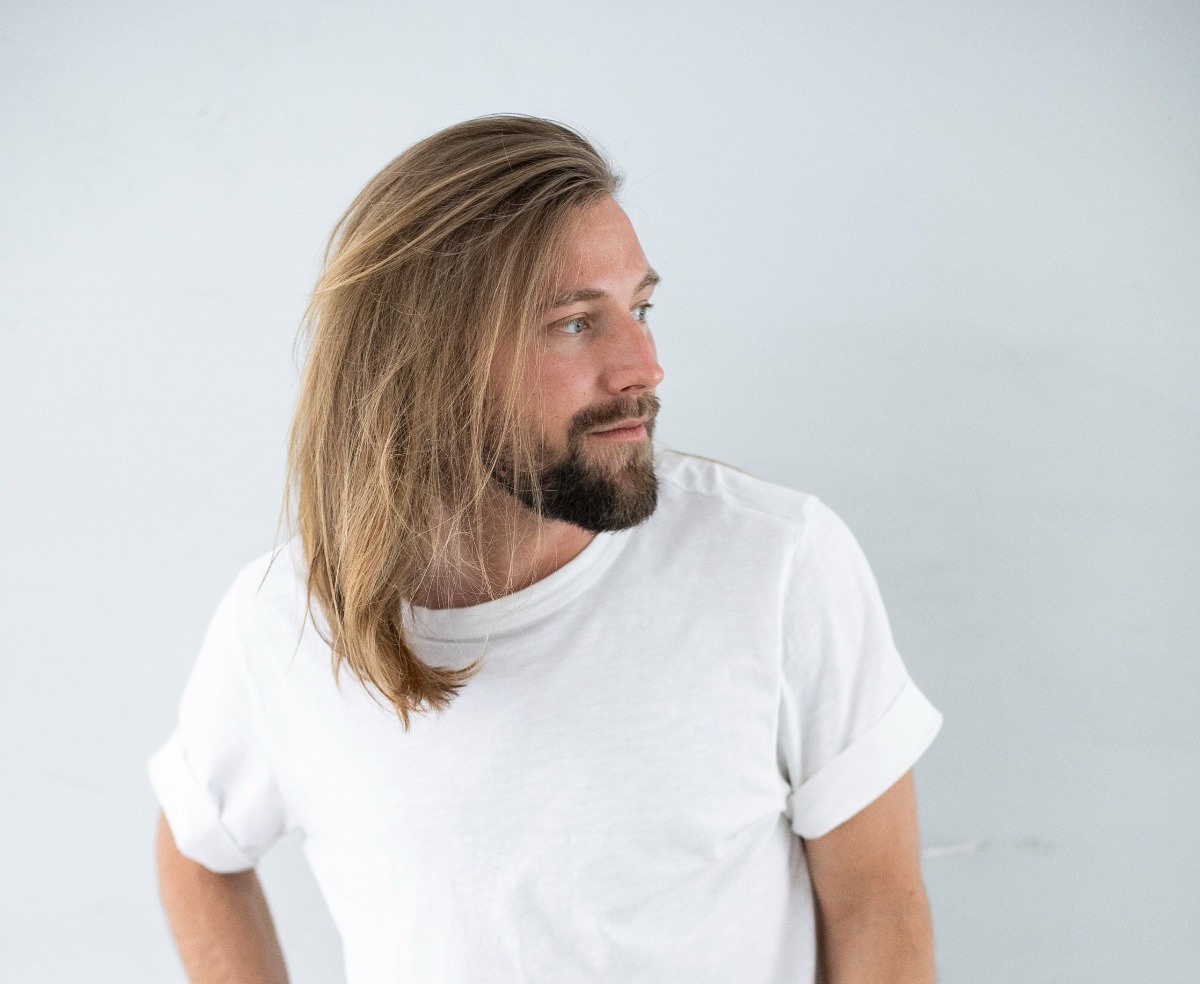
Through the prism of the atmosphere
Interview with architect Toms Kampars
Until August 6 of this year the exhibition Celebrate Porcelain with Kuznetsov organized by Zuzeum Art Centre gives visitors a chance to get acquainted with the story of the Kuznetsov porcelain and faience factory founded in Riga in 1841. As the only factory that carried the name of the Kuznetsov family also in the interwar period, it developed its own unique porcelain painting style. It was developed through the interaction of Slavic and Latvian culture and Latvian artists being involved in creating the porcelain dishes. This eclectic diversity of porcelain objects along with visual archive materials can be discovered in the exposition created by the curator of the exhibition Marta Šuste and the architect Toms Kampars.
Creating a slightly mystical atmosphere with the help of dimmed lighting, the architect of the exhibition slowly takes the visitor through the process of producing porcelain and brings them closer to the secrets of its creation. The architect admits that the same as in his other expositions, his goal was to create an adventure in the room.
Toms Kampars last year’s Zuzeum exhibition “Growing Out? Growing Up? Contemporary Art Collecting in the Baltics” design has been nominated for the Latvian Design of the Year Award 2023 in the environmental design category, the finalists of which were announced on May 31. The architect and his team have just finalized work on the creation of the Latvian pavilion “T/C Latvija” at the 18th international architecture exhibition of the Venice Biennale, which will run until November 26.
Toms Kampars runs his architecture studio in Riga. After graduating from Riga Technical University (2009-15), Kampars continued his master’s studies at the University of Applied Arts in Vienna (2016-20), where he graduated from the studio led by Kazuyo Sejima (SANAA) and Cristina Díaz Moreno & Efrén García Grinda (amid.cero9). The architect gained experience in such architectural offices as Henning Larsen (Copenhagen, 2013-14), Heatherwick Studio (London, 2014), Sarma & Norde (Riga, 2015-16), Delugan-Meissl Associated Architects (Vienna, 2017-20). Kampar has collaborated with the research group [Applied] Foreign Affairs (Vienna and Accra, 2018-20) on the development and implementation of a market pavilion in the village of Guabuliga in the West African country of Ghana.
View from the exhibition “Celebrate Porcelain with Kuznetsov” at the art centre Zuzeum. Photo: Ansis Satrks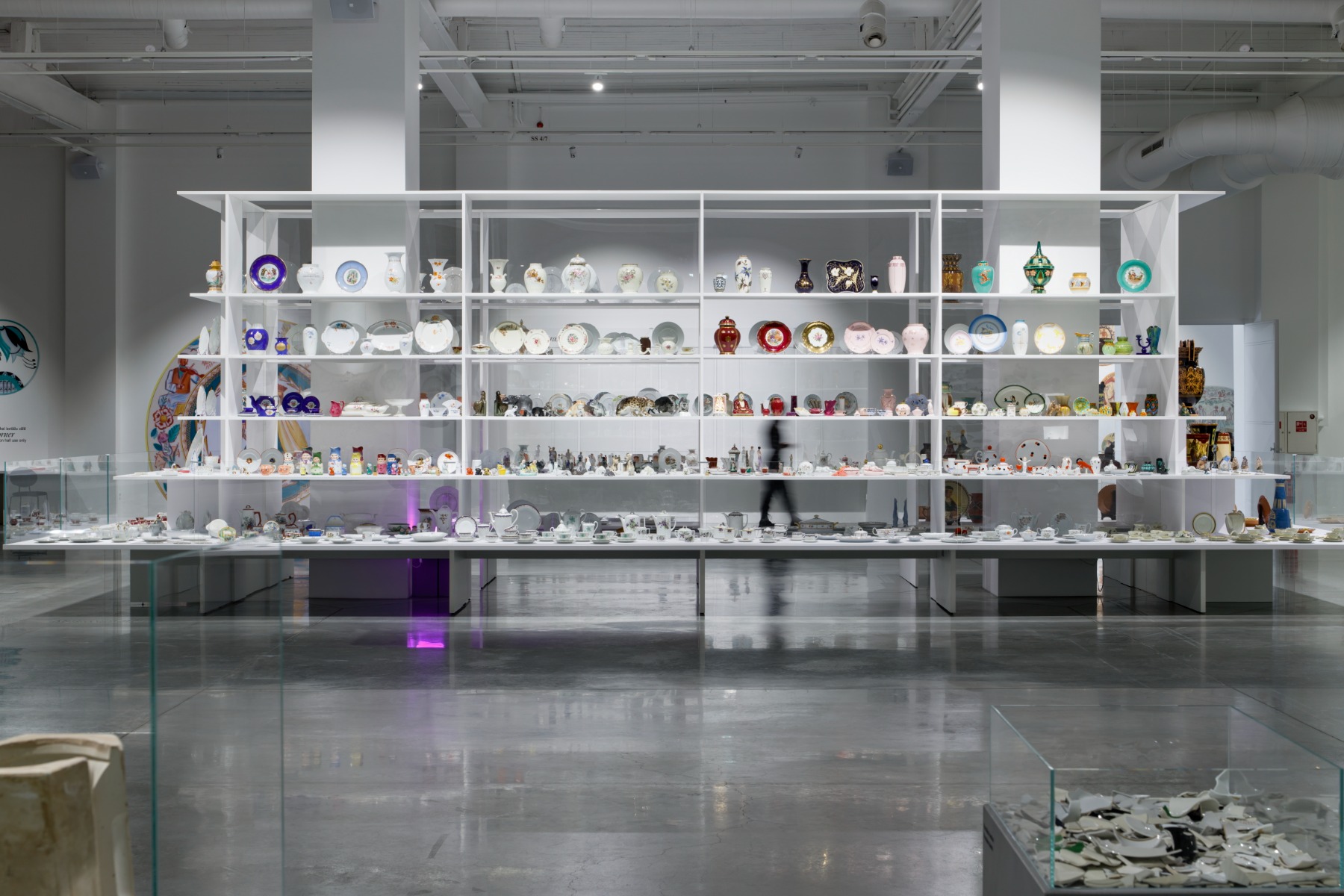
The exhibition “Celebrate Porcelain with Kuznetsov” includes more than 1000 porcelain, faience and clay objects. I suppose it was a challenge on its own to set up a display with this many units.
The biggest challenge was to create an exhibition of such a large number of small objects in such a large space. The Zuzeum exhibition hall is almost 1000 square meters wide, and for the objects to not get lost, their compositional arrangement is important.
For the most part, these objects are in controlled conditions, namely on the shelves of archives. It is not possible to freely access them, so most of the exhibits of the exhibition never came into my hands – I only viewed them in Excel tables. It was a big surprise how when exposed, the objects sparkled!
So for the objects that you have only seen in pictures, you had to find the right place and way of presenting them so that they fully reveal themselves and create a dialogue with everything else. What approach was taken to physically do this? Maybe some formula?
Yes, by the way, mathematics was really present in this process. The curator team of the collection, under the leadership of Annija Grīsle, helped to create a kind of a model for the area of different types of porcelain objects, in which a certain number was accounted, for example, tableware, teapots or small plastics. In this way, it was also possible to determine the necessary parameters of table tops. Alongside this mathematically pragmatic side, there was undeniably room for improvisation. I prefer a dynamic environment, changes, spontaneity, that is why I like to work in exhibition design, where it is never possible to plan everything to the end. I must admit that also in this exhibition some compositions were vague and unclear until the last moment and came as a surprise to everyone. Such situations are rare in architecture.
View from the exhibition “Celebrate Porcelain with Kuznetsov” at the art centre Zuzeum. Photo: Ansis Satrks
You mentioned the width of the Zuzeum exhibition hall, and this is not your first time organising his exhibition space. What is your relationship with the space? How does it lend itself to your architectural design approach?
I like this space – it is like the traditional white cube but at the same time it has its niches, brickwork, skylights and large, massive wooden beams. There are so many variations available.
When working with the Baltic collectors’ exhibition, I wanted to use the roof structure more, so all the artworks were hung as if in the air. No exhibition wall rested against the floor. This arrangement, as a strategy, provides mobility, which was exactly what was needed in the unpredictable conditions of the Covid-19 pandemic at the time.
View from the exhibition “Celebrate Porcelain with Kuznetsov” at the art centre Zuzeum. Photo: Ansis Satrks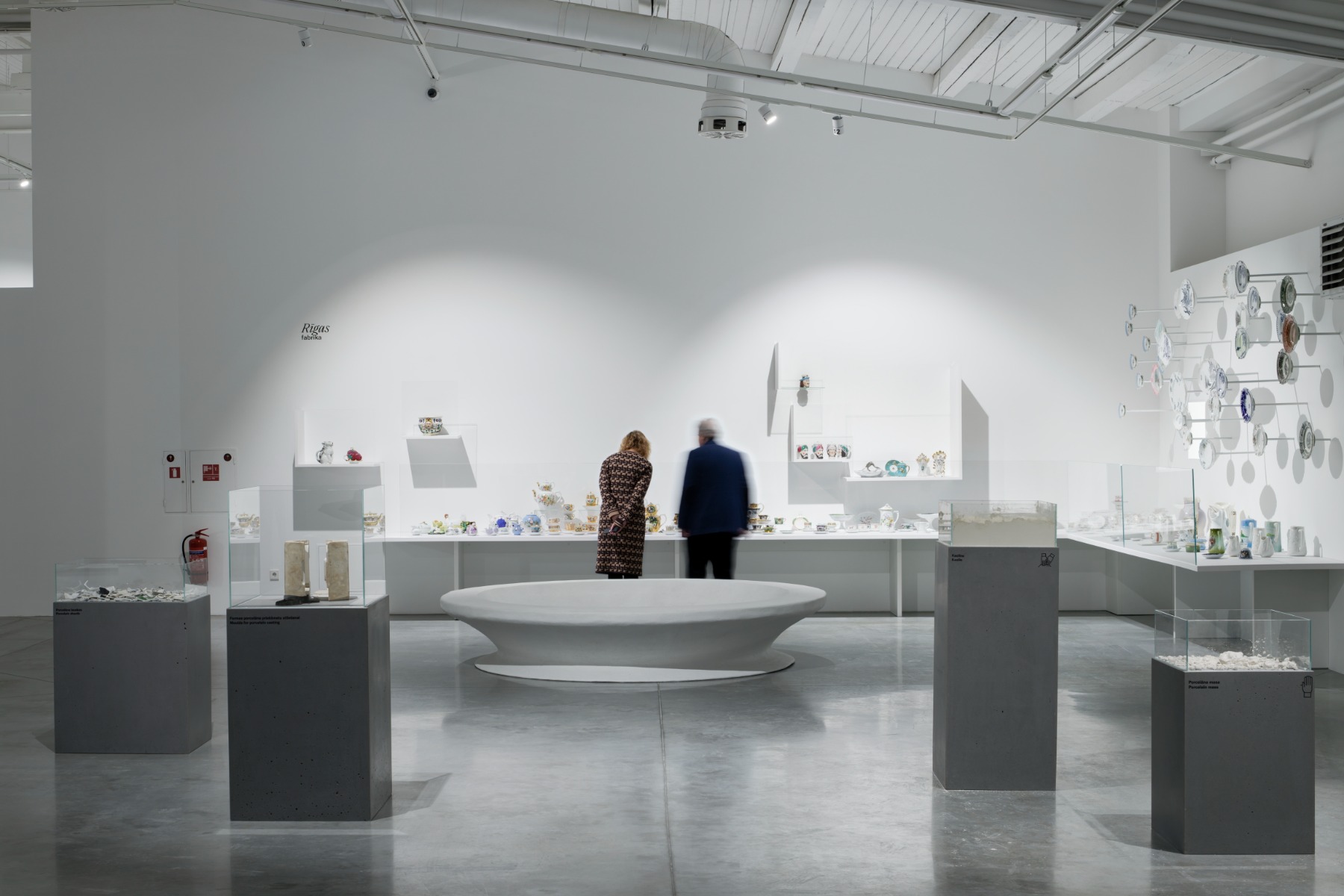
In this case, the exhibition’s architecture is more grounded.
It was clear from the first moment that to exhibit the tiny units of porcelain work, there have to be larger objects that could fill the space and attract attention. That is why interactivity is required. That is why also two larger objects were created – a cup and a kettle. The profile of the cup, enlarged twenty times, serves as a bench on which the visitors of the exhibition can sit down, relax and think over what they have seen. On the other hand, the "negative" of the teapot is designed in such a way that it can be entered, reminding us of molding as an integral process of porcelain creation. It was important for me to create something physically tangible in an exhibition where everything is so fragile and enclosed.
The curator Marta Šuste relates the concept of “celebration” to the exhibition, while you emphasize understanding the context – the process of making porcelain, the history of Kuznetsov factories. How did you manage to find balance? How did you deal with this exalted atmosphere?
The rooms are deliberately made quite dark, which introduces a kind of seriousness and slows down the pace of people’s movement. The dimmed lighting makes the visitors calmer, slower, more careful. On the other hand, the celebration is expressed in the porcelain compositions on the tables. It seems that people just celebrated there, left the tables, and now there is a slightly nostalgic, but at the same time optimistic feeling left. Optimism is created by the shining, colorful dishes and the individual diversity of each exhibit.
Creating an atmosphere is one of my creative engines. Whether it is for architecture or for an exhibition, I always look at the space through the prism of the atmosphere. It is, of course, made up of light. The previous exhibition – Baltic collectors in the art center Zuzeum, which took place at the beginning of summer, after the long stagnation of Covid-19, from the point of view of light was deliberately designed as a very light and airy event. On the other hand, in the case of the porcelain exhibition, I wanted to move towards darkness and mysticism, which slows down the movement of visitors, and at the same time seemed like a pragmatic response to the energy crisis and the increase in electricity prices.
View from the exhibition “Celebrate Porcelain with Kuznetsov” at the art centre Zuzeum. Photo: Ansis Satrks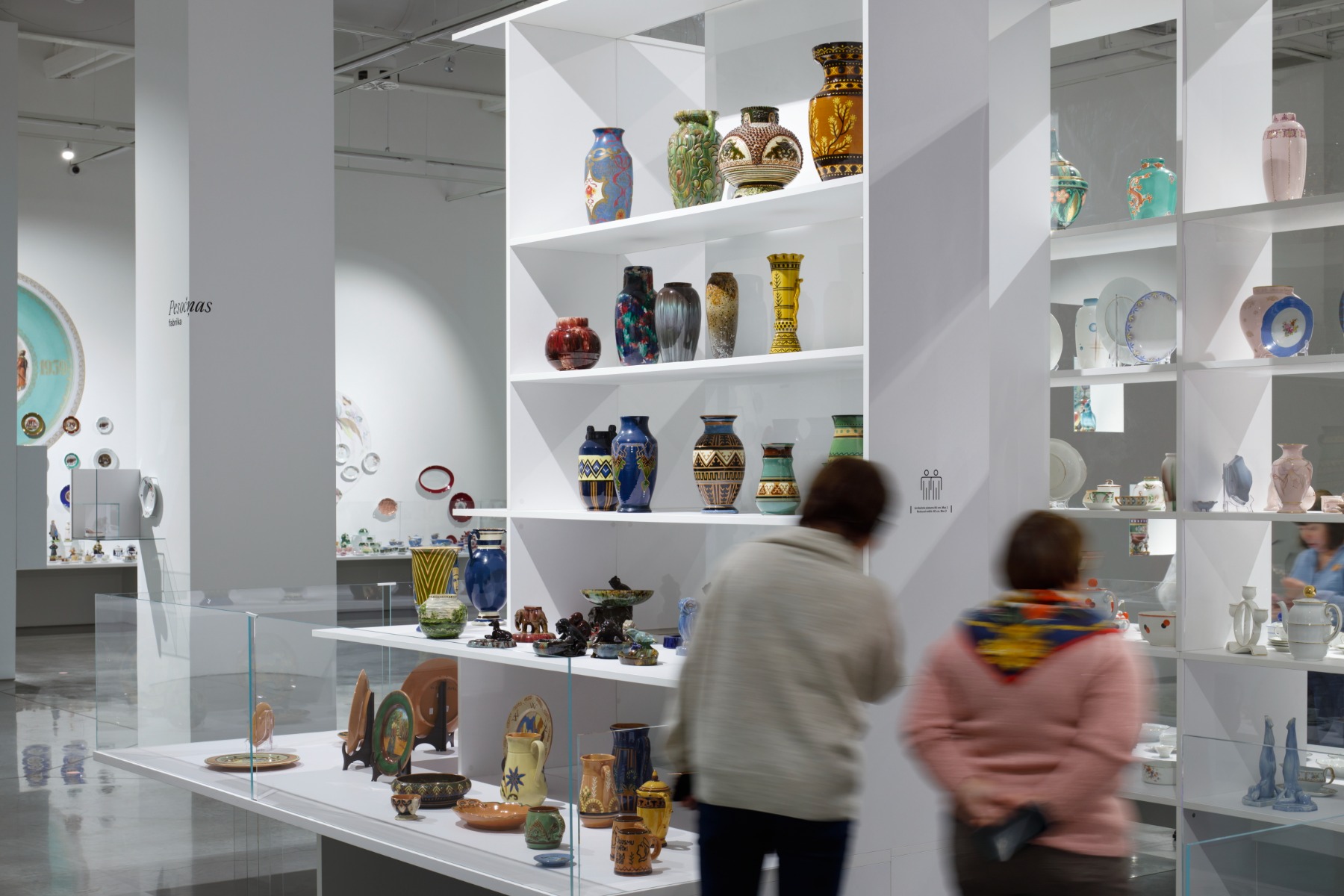
What are the main questions which you usually ask the curator of an exhibition in order to agree on how to create its spacial narrative?
In this case, two main questions were addressed – the chronological order and resistance to providing information. It was important for me to understand how the porcelain stands can be divided or how the story is made. In the curator’s view, it had to be a chronological narrative, in which the visitor gets to know Kuznetsov’s factories in sequence, arriving at the factory in Riga – during the period of Latvia’s first independent state. Initially, I might have been a bit skeptical of this approach, as it seemed to be in a sense already common or even boring. However, the curator’s reasoning is based on the fact that porcelain is so diverse that it cannot be structured in any other way – neither by form nor by categories. Chronology is actually the only serious backbone that can be given to porcelain. It also provided the main framework I was working with.
The second important thing – what kind of information should be given and how much? Visitors to the exhibition have often admitted that there is a lack of information. Yes, the exhibition is deliberately designed with a minimalist approach toward information. The aim was not to contaminate the exhibition with anything distracting, allowing the dishes to speak for themselves. Sometimes at exhibitions efforts have been made to over-educate people, to retell all the nuances and facts, but not everyone has the time and interest for that. Those who are interested in the given topic will find the information themselves. This exhibition is different in that each item does not have a number and title, but an excellent catalog and booklet have been compiled.
What in your opinion is a contemporary exhibition arrangement? Where is exhibition design heading today?
In my opinion, the role of strategic design is increasingly coming to the foreground. This means that the process itself is also part of the design. How something is built matters – what was brought from where, to what extent is it reusable and how big is the ecological footprint. For example, the main material in the exposition of the Venice Architecture Biennale is cardboard – a very strong, ecologically excellent, but often forgotten material. Although I am always looking at this side for materials, in the case of the porcelain exhibition, it was inevitable to use glass to protect these precious objects. Modular systems were used in the architecture of the exhibition. The glass showcases were designed as open as possible with a small number of planes – they are definitely not closed boxes, each with its own battery or lamp. Also, glue was not used anywhere, because glued things are more difficult to recycle. The constructions used a milling technique that allows the elements to be taken out, removed, and placed in storage for the next exhibition. All of that was considered. The Baltic collectors’ exhibition, on the other hand, was made from a very small amount of materials and it takes up very little space in the warehouse.
The other thing that defines a contemporary exhibition is empathy. This, in my opinion, is returning to design and will be one of the future values. My approach is also empathic. I’m trying to find a system that works for everything – content (including artwork owners, collection maintainers), exhibitions (including their creators), and viewers. In my opinion, everything should be in harmony.
View from the exhibition “Celebrate Porcelain with Kuznetsov” at the art centre Zuzeum. Photo: Ansis Satrks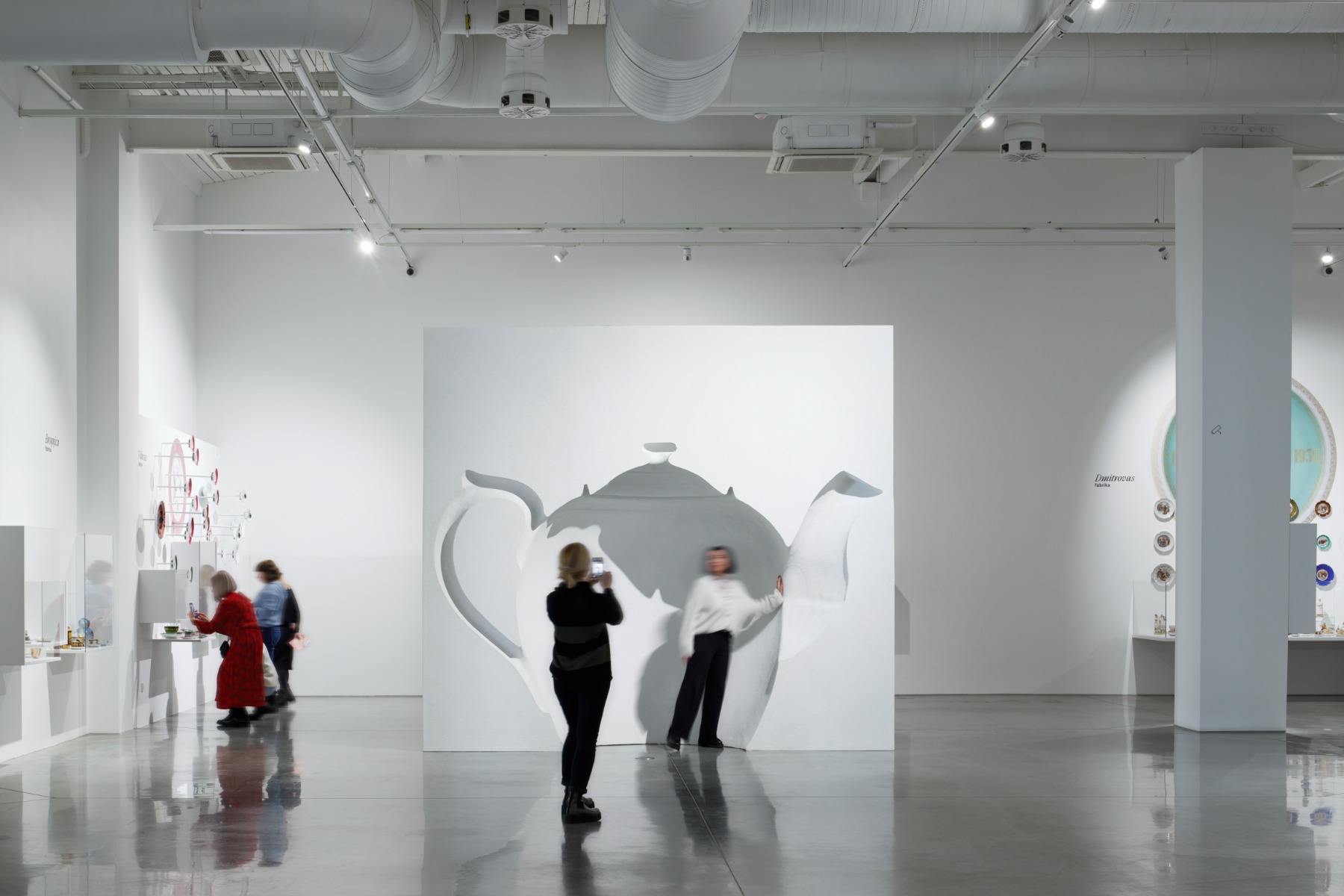
Modern exhibitions are often created with the aim of creating social media exposure, attracting attention like never before. To what extent was this technique used in this Zuzeum exhibition?
Probably everyone has already seen the large teapot motif used in the design of the exhibition. It must be admitted that it works very well, like it or not – everyone enters it and takes pictures. At the same time, each visitor also finds their own corner and their own dish. Everyone has their own unique perspective. To plan from the outside which will be the right photo corner would actually be quite arrogant. There is always this photographic freedom, but if you take care of such a place, people like that too.
In general, I try to create the lightest and most transparent exhibition possible. My job is to set the stage/background, and I’m happy if the artwork itself dominates those social media pictures. An architect or designer should not try to surpass the content of the exhibition and impose something of their own.
However, it must be admitted that in world practice, the arrangement of the exhibition often overshadows the content itself. What are your thoughts on this? Was it dictated by the habits of exhibition visitors, the desire of exhibition organizers to attract the audience’s attention, or perhaps the interests and ambitions of the designers themselves?
It is difficult to find a specific reason for this. Ambition definitely takes its toll. If it is important for an architect to represent himself on social and design media – of course, an appropriate product will be created accordingly. While traveling the world, including African countries, I happened to see buildings designed by Western architects, which are beautifully photographed in the media, but in real life, they are half-ruined or abandoned. However, this is not correct.
View from the exhibition “Celebrate Porcelain with Kuznetsov” at the art centre Zuzeum. Photo: Ansis Satrks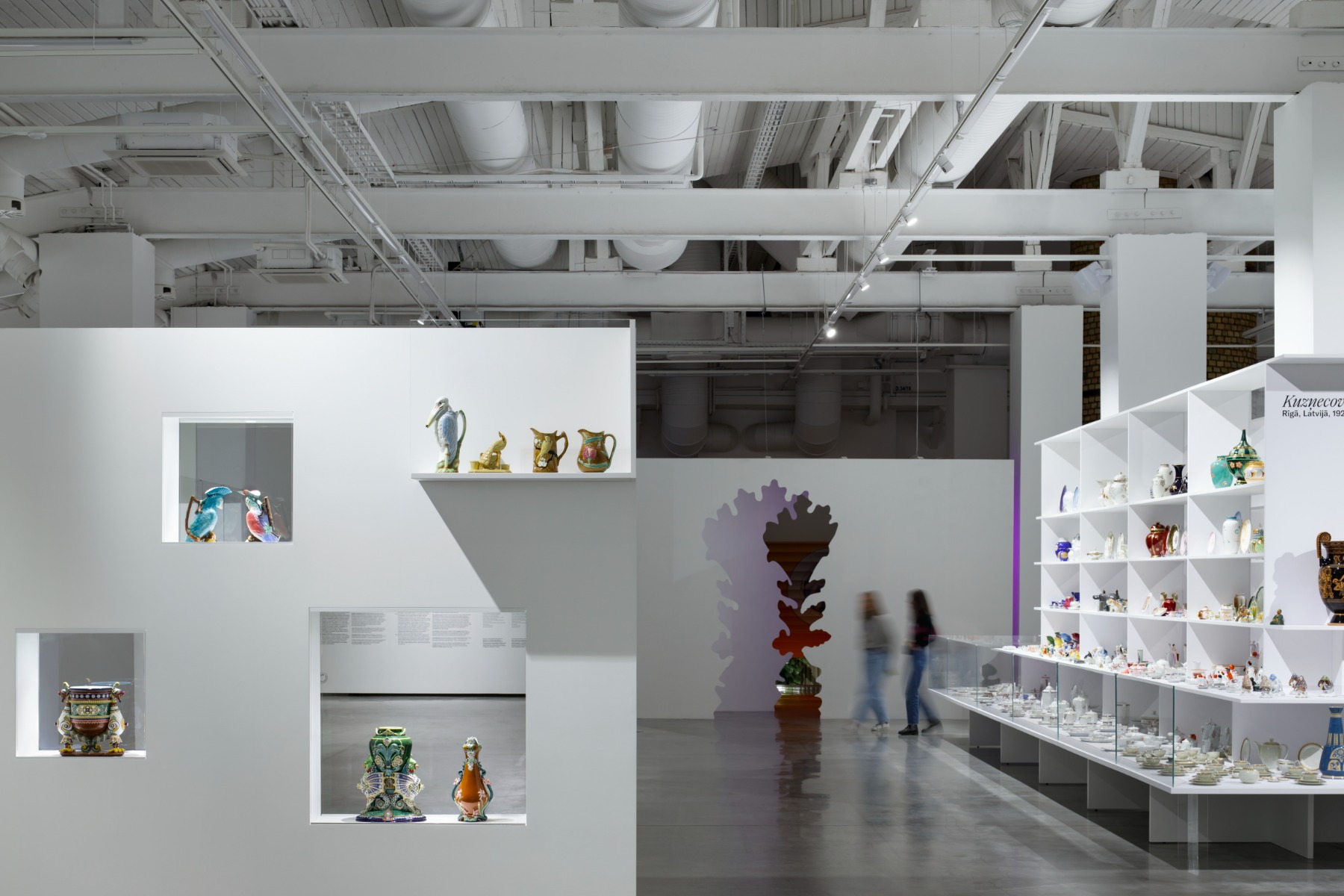
Coming back to the historical porcelain – how do you, as a design professional, look at it? What do you think is the contemporary dimension of porcelain?
Yes, I still ask myself this question – how does porcelain fit in today? There is a feeling that it is elitist, expensive, and inaccessible. More of a collectible item. However, porcelain as a material is very durable and long-lasting. It does not degrade, deteriorate, or rust. It has a sustainability factor that we rarely experience these days. If porcelain is not broken, it remains unchanged even for several centuries.
The second thing is the artistic performance of porcelain. It’s clear to see that a huge amount of time and energy has been invested in the development of the items. Today, art and design are created at lightning speed, so these minute, meticulous works of art are a little confusing for the modern person. They make you slow down. Historic porcelain makes you stop and delve deeper. It reminds us that there was a time when things moved slower, with energy being invested into the process and not rushing to meet market demand.
View from the exhibition “Celebrate Porcelain with Kuznetsov” at the art centre Zuzeum. Photo: Ansis Satrks
What other personal reflections did this exhibition lead to?
Also in the context of this exhibition, one can feel how much the society is divided into interest bubbles. Those people who came to the exhibition dedicated to collecting contemporary art in the Baltics, do not come to the exhibition of historical porcelain, and vice versa. On the other hand, I like history very much, I am very interested in it. My grandfather was a history teacher and school principal. If I didn’t have this career, I would like to pursue it in the field of history or research.
Knowledge of history opens the layers of culture and art formation. And this exhibition really opened my eyes. At first, it might seem like a glorification of Slavic culture, which, in context with the Russian invasion of Ukraine, is of course unacceptable. However, the Kuznetsovs themselves were also victims of the ruling regime in Russia and fled to Riga as a safe haven – much more liberal, freer, and closer to the West. The story of the Kuznetsov exhibition is about entrepreneurship, people’s excitement, enthusiasm, also about historical technologies, and artistic creativity. It is worth going deeper and looking at the topic more broadly.
View from the exhibition “Celebrate Porcelain with Kuznetsov” at the art centre Zuzeum. Photo: Ansis Satrks
What is your childhood porcelain story?
One of my most vivid childhood memories is the pot painting camp in Valmiera, which I participated in when I was four years old. At that time, I created my first dish design myself, which was kept at my home for a very long time. They were such abstract figures and a bit of something from a car design. It was my childhood porcelain, maybe not quite Kuznetsov, but personal enough.
Where are you currently in your professional trajectory and territory - is it architecture or is it design?
I am between architecture and design, and I am still exploring this area. Admittedly, I do very contrasting things at the same time, including drawing a lot of master plans and architectural visions of large areas. I like that too, because I see the possibilities of design expression at different scales. Since architecture in Latvia is very slow, it often takes almost ten years to build something, – in the meantime, I try to create works on a smaller scale as well. I am always open to challenges and new aspects of my profession. I am not comfortable with stagnation.
Title image: Toms Kampars. Photo:Lolita Epnere